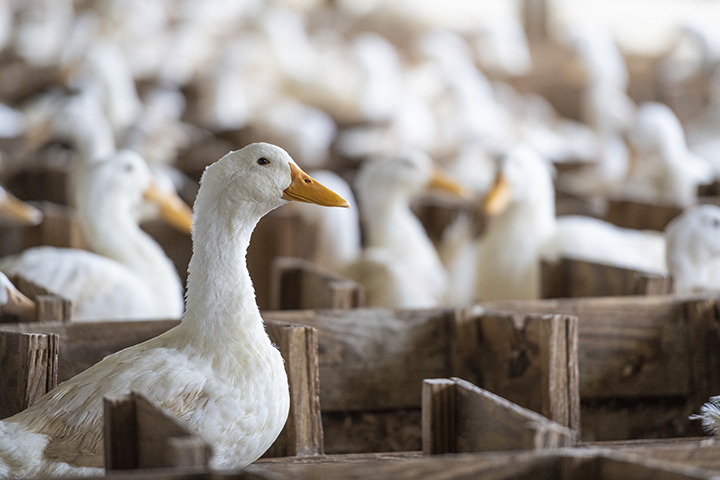Partner Spotlight: Purina
“A happy and healthy duck is a tasty duck” is more than a snappy slogan at Joe Jurgielewicz & Son, Ltd. This phrase has been a guiding principle for four generations of the family business, and proper nutrition remains a key component in raising consistently superior flocks. To achieve vigorous health and proper growth, the company partners with Purina Animal Nutrition LLC to produce a specially crafted feed.
This highly nutritious duck diet remains closely monitored by the Jurgielewicz’ state of the art research and development facilities at their operation in bucolic Strausstown, Pennsylvania. “We’re constantly testing our dietary formulations,” says Dr. Zack Lowman, our resident geneticist. “That ensures we’re providing the optimal diet for happy, healthy ducks.”
Keith Fleetwood, a commercial poultry and feed mill specialist at Purina Animal Nutrition Center, reveals the many steps entailed in creating an exclusive and premium dietary regimen. The foundational ingredients are straightforward essentials – raw corn and raw soybeans, some of it grown on the 500 acre Jurgielewicz farm that supports eco-friendly and sustainable practices. The balance of products necessary to nourish more than six million ducks a year is sourced from local farms in Pennsylvania and nearby Maryland. Trucks then deliver these commodities to two designated feed processing facilities that meet the needs of this highly specialized client.
When the milling facilities process these grains, a proprietary blend of vitamins and minerals is introduced to the mixture for a nutritionally balanced diet. (Hormones and antibiotics are never added.) Purina is diligent about evaluating all ingredients used in the feeds for Jurgielewicz ducks, with purchasing specs on each item mirrored by receiving specs. “We check and evaluate everything before actually letting it be introduced into what becomes the feed mill. It has to go through a series of vigorous tests that meet all those requirements are performed. Then we can bring those products into the facility to utilize them for blending to manufacture feed for Jurgielewicz,” Fleetwood says. Additives include just vitamins, minerals and different processed and unprocessed grains.
The Purina nutritional staff regulates diets to meet the three different stages of a duck’s growth and development at certain ages. “We know what it takes to build the skeleton of the animal, and what is needed to build the meat and fat on the ducks. They have a very strict balanced diet,” Fleetwood continues. The initial diet is a starter feed that builds bones and starts putting tissue on the animal. “Then they go to a grower feed that has a little bit lower protein – the skeleton has been built and now we’re building the meat to meet the requirements for Jurgielewicz’ bird conformation. The finisher feed has a little more calories than the previous two feeds. As the name says, this finishes the ducks out until they’re ready for processing. The ducks, frankly, eat better than you and I.” Each diet supports and complements the specific meat to fat ratio established through the evolving genetics program at Jurgielewicz. Because different genetics would have different requirements, Purina has about 2,000 diets to suit a variety of species.
Ongoing analytical nutrient profiles of all the ingredients take place every week, with a full evaluation of each component compared against the average or mean measurements. Weekly reformulations then take place. Because of the minor tweaking– just adding a little more of one ingredient than another – the ducks never know there’s a change in formula.
For transporting, the processed feed is put into compartmentalized trucks that go to the farm, and a series of hydraulic auger systems go to the top of the feed bins to be deposited. “From there, that feed goes through to the feeding system inside the houses for the ducks. It flows automatically, so the ducks are never out of feed and they always have feed in front of them,” Fleetwood says. “Jurgielewicz has done a really good job of evaluating how much feeding space is needed to be available for the number of ducks that are housed in a building. When you go into the houses you don’t see ducks fighting to get to the feed. You never see that happening at Jurgielewicz. There’s ample space and they can eat at their leisure.” A lack of these amenities can trigger competitive behavior where the ducks pick at each other or their own feathers. And that makes for happy ducks. “If you could see these animals when they’re being raised, you’d know how comfortable the are,” Fleetwood concludes. “We love educating people.”







